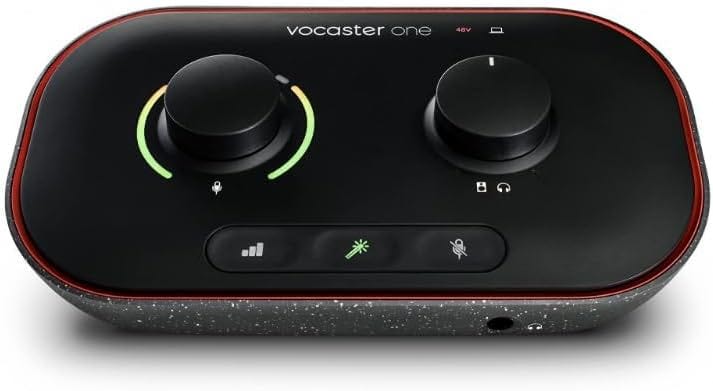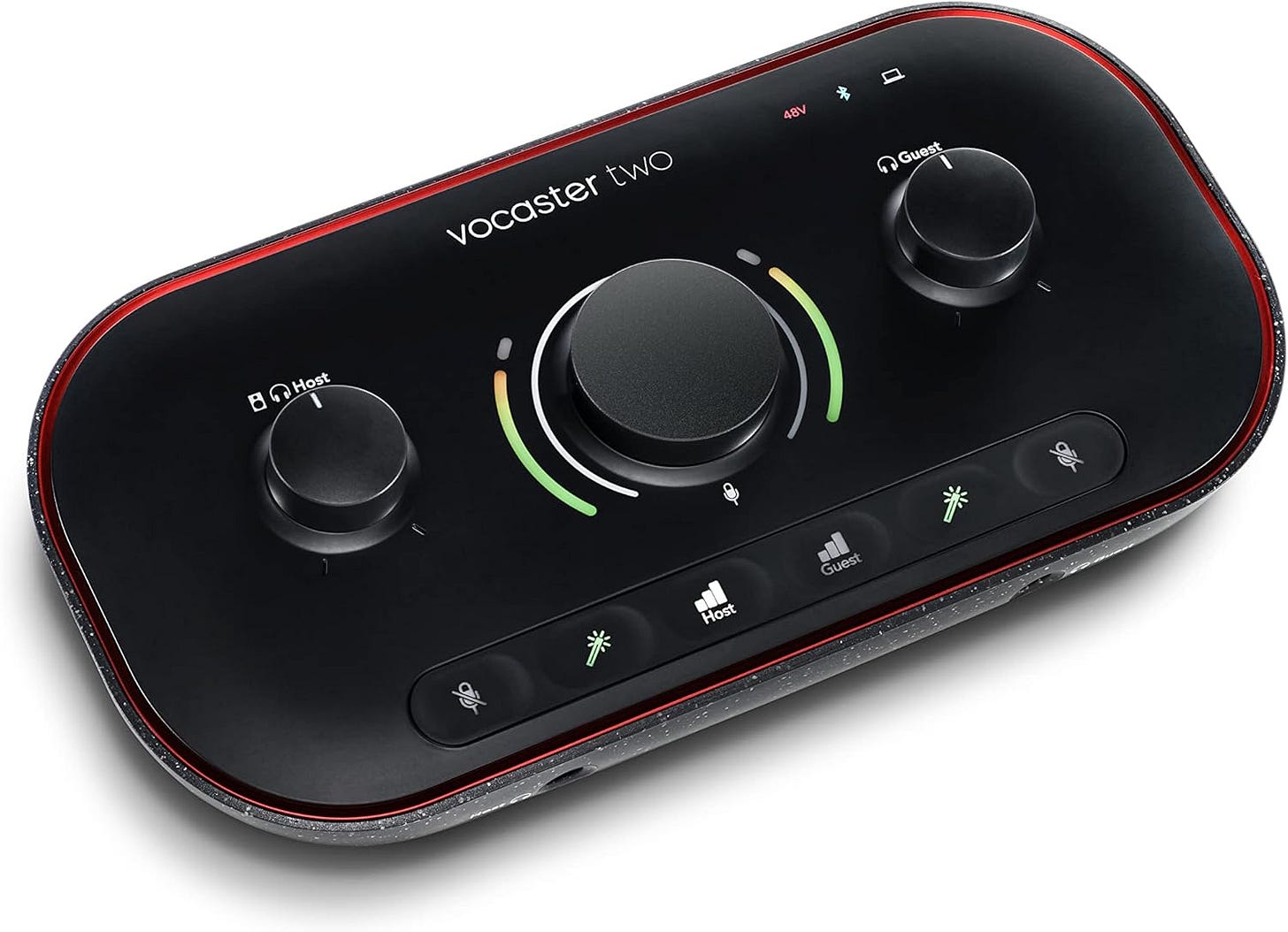The Best “Live Streaming” Audio Interface Options for Podcasters
More and more podcasters are taking advantage of the power of live streaming to connect with existing listeners in a new way as well as reach new listeners. As podcasters, we have the presentation and organization skills to deliver live content and we have most of the needed equipment, but live streaming isn't podcasting and there are some important things to keep in mind if you’re considering doing it.
Like podcasting, clear, professional sound can make all the difference in engaging your audience and standing out with live streams. It helps to have an interface that can deliver this.
But … most “recording studio” podcasting audio interfaces weren’t designed with live performance in mind.
The Vocaster line from Focusrite is different. With HUGE buttons and knobs on a simple interface, it lets you focus on your delivery, content, and audience interaction, not the tech.
How to Choose the Right Audio Interface for Live Streaming
When selecting an audio interface for live streaming, consider factors such as the number of microphone inputs you need, ease of use, portability, sound enhancement features, and compatibility with your devices and software. You’ll also want something that offers reliable gain control and mute options to manage your audio effortlessly during live broadcasts.
Both Focusrite Vocaster models include Auto Gain and Enhance features to automatically adjust your sound for clarity and presence, making them excellent choices for beginners and experienced streamers alike.
Focusrite Vocaster One
For solo live streamers looking to step up your live streaming or podcasting game without getting bogged down in complicated setups, the Focusrite Vocaster One is a solid pick. It’s designed to deliver studio-quality sound fast, with features like Auto Gain that adjusts your levels automatically, and Enhance presets that give your voice a nice polish in just a click.
Live streaming is messy, so there’s a mute button for quick interruptions that’s an absolute lifesaver when something comes up you don’t want on the stream, such as a siren or other loud noise. And you can even connect your phone or camera directly, making it super versatile..
Its small footprint and lightweight design mean it won’t clutter your desk, and since it’s powered by your computer, you don’t need to mess with extra power supplies.
Whether you’re jumping into live streaming or just want smoother, clearer audio for your streams, the Vocaster One makes the whole process a lot less intimidating.
You’ll love the feel of the knobs and the obvious mute button setup for streaming. The Auto Gain and enhancer presets make quick vocal adjustments a breeze. And the red light helps avoid accidentally muting yourself during streams.
It’s the perfect tool for streamers who want great sound without complicated settings.
Highlights
Auto Gain and Enhance for Easy Sound Adjustment
Compatible with XLR Microphones and USB Devices
Compact and Lightweight Design
USB-C Connector with USB 2.0 Interface
Supports All Audio Recording Software
Mute Function for Streamlined Recording
Why You’ll Like It
Studio-quality sound with over 70dB gain — no booster needed
Auto Gain sets your levels quickly so you can focus on streaming
Enhance presets let you tweak your voice with a single click
Handy mute button with clear red light for easy control
Connect your phone or camera directly for seamless integration
Focusrite Vocaster Two
Have a cohost? The Vocaster Two has you covered with two mic inputs and two headphone outputs, so you can record comfortably without extra gear.
Like the Vocaster One, the mute button on the Vocaster Two has a clear red light keeps things running smoothly during live sessions and makes sure you won’t accidentally silence yourself (or your cohost). Plus, it can connect to your phone via Bluetooth, making it easy to capture remote guests.
It’s compact, lightweight, and is powered by your computer—no extra power bricks needed. Whether you’re hosting a two-person stream, podcasting with friends, or just want reliable, professional sound, this interface keeps things simple and effective.
Highlights
Two Mic Inputs and Two Headphone Outputs
Auto Gain and Enhance for Professional Sound
Bluetooth Audio Connectivity
USB-C Connector with USB 2.0 Interface
Supports All Audio Recording Software
Compact and Lightweight Design
Why You’ll Like It
Studio-quality sound with over 70dB gain — no booster needed
Auto Gain quickly sets your levels so you can focus on your content
Enhance presets polish your voice with just one click
Two mic inputs and two headphone outputs for hosts and guests
Mute button with clear red light for easy control during live sessions
Bluetooth and camera connectivity for seamless audio integration
FAQ
What are the Key Features that Make Focusrite Vocaster One and Two Ideal for Live Streaming?
You’ll find that both the Focusrite Vocaster One and Two are designed specifically to simplify your live streaming and podcasting experience. The Vocaster One is perfect if you’re recording solo, offering auto gain to automatically set your microphone levels, an enhance button to improve your vocal quality with one click, and a handy mute button so you can control your audio easily during streams or calls. The Vocaster Two builds on this by providing two mic inputs and two headphone outputs, allowing you to include a guest or co-host seamlessly. It also adds Bluetooth connectivity so you can integrate phone audio directly.
Both interfaces are compact, lightweight, and powered via USB, making setup quick and hassle-free. You benefit from professional-grade sound without needing extensive audio knowledge.
How Do I Choose Between the Vocaster One and Vocaster Two for My Streaming Setup?
Your choice depends largely on your streaming needs. If you primarily stream alone and want a simple, effective way to improve your microphone sound, the Vocaster One is an excellent choice with its single XLR input and straightforward controls.
If you often host guests or want to monitor multiple audio sources, the Vocaster Two’s dual mic inputs and headphone outputs offer more flexibility. The Vocaster Two’s Bluetooth feature is also a plus if you want to bring in phone calls or other wireless audio sources during your stream.
Consider whether you need to interact with others live or prefer a solo setup; this will guide you toward the interface that fits your workflow best.
What Practical Tips Should I Know to Get the Best Audio Performance from These Interfaces?
To maximize your audio quality, start by placing your microphone properly to minimize background noise and avoid feedback loops. Both Vocaster devices feature auto gain, but it’s still helpful to adjust your mic position and room setup for clarity. Use the enhance feature to quickly improve your vocal tone, but don’t hesitate to experiment with your streaming software’s EQ and compression settings for a custom sound. Also, be aware that you will always hear your mic through the headphone output, which helps with monitoring but means you should use headphones to avoid audio loops.
You’ll want to avoid placing the interface near other powered USB cables or hubs to prevent interference. Lastly, the USB cable provided is quite short, so consider using a longer, high-quality USB-C cable for flexible placement in your streaming space.
Wrapping Up
Choosing the right audio interface can significantly improve your live streaming and podcast quality. The Focusrite Vocaster One is ideal if you’re streaming solo and want a straightforward, reliable setup. If you often collaborate or host guests, the Vocaster Two offers the flexibility of multiple inputs and Bluetooth connectivity.
Both interfaces provide professional sound enhancements that help you stand out. Investing in one of these devices can streamline your workflow and ensure your audience hears you clearly and confidently.





